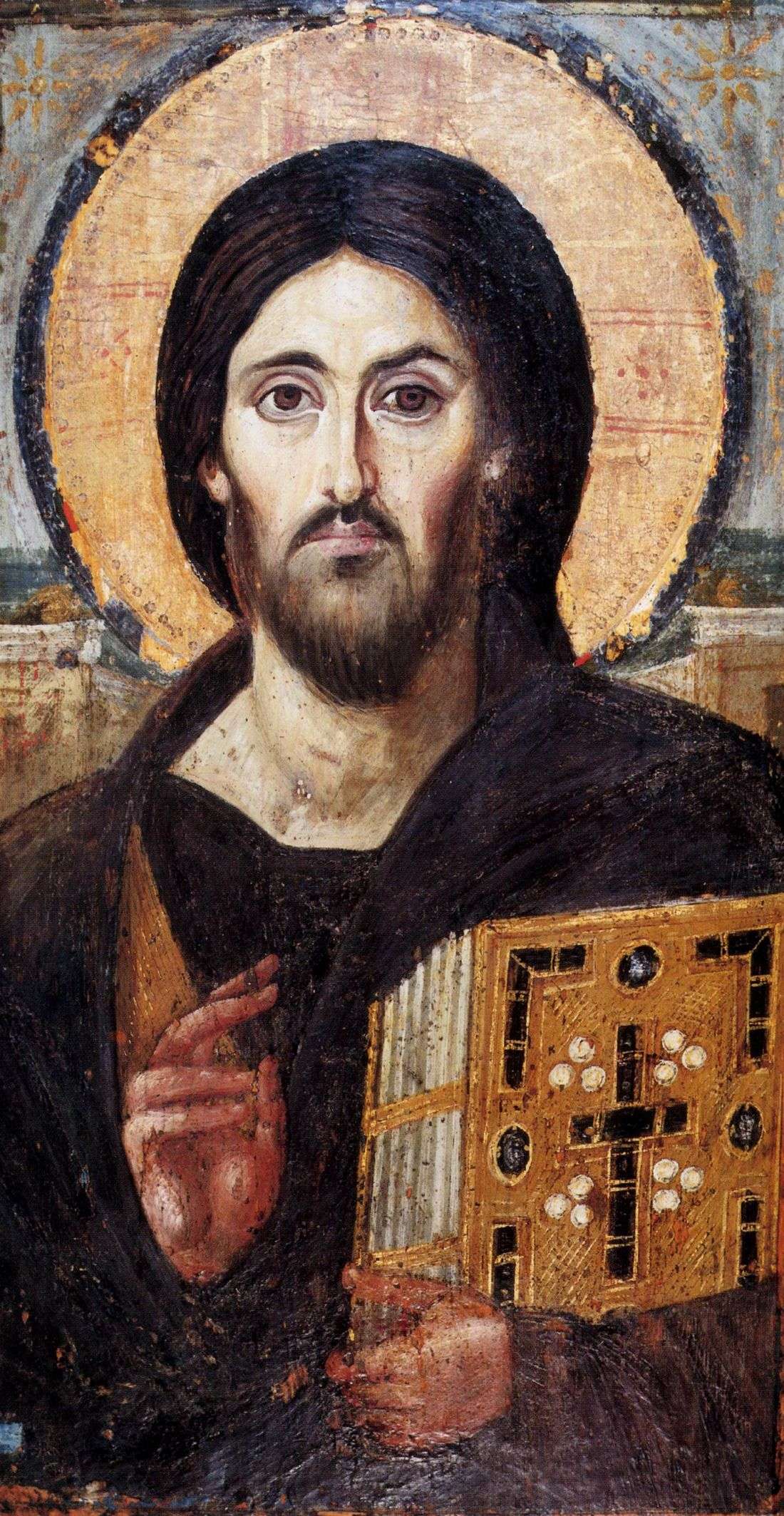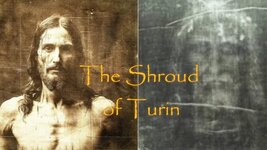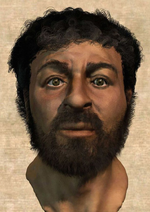Those letters are fake, cannot be verified before the 6th century, and have no original Greek manuscripts to compare them to (which 100% means they are fake since all documentation was done by the Library of Alexandria, which was run by Greeks).
There is no way to confirm via this method if the letters are fake because we do not know the exact date of the destruction of the Library of Alexandria. It is a bit of a mystery, as there are six possible leads for it:
48 BC: Julius Caesar may have burned the library during his civil war in Egypt. However, some sources say the library survived and was rebuilt.
272 AD: Emperor Aurelian may have destroyed the library during his war with Zenobia.
297 AD: Diocletian may have destroyed the library.
391 AD: Christian "zealots" may have destroyed the library during the sack of the Serapeum.
400 AD: The library may have been fully destroyed around this time.
642 AD: Muslim Arabs may have destroyed the library after conquering Egypt, purging images and knowledge associated with the old world.
When it was destroyed is key for understanding what knowledge was kept until what date, which is suitable for other discussions as well as this. Some of the lost knowledge was on scrolls in other locations, but a majority of it is gone forever. There may have been more incredible detailed first-hand accounts of Christ that the world will never know about.
It appears these letters are but Catholic forgeries designed to create some kind of legitimacy of Christ's appearence to match European features. I see they are posted on the Vatican's portal, with no context:
https://www.newadvent.org/fathers/0810.htm
I understand your skepticism of the papacy, however the history of migration patterns and genetics don't lie. European features were much more prevalent in earlier days than they are now, where some will only resurface in certain Levantines with mixed ancestry. Everyone around this area at that time, the Iudeans especially ones that were not mixed with Edomites and Canaanites (which was Christ's lineage from Abraham), would not have appeared to be an entirely swarthy people. This does not automatically mean "Blonde hair, blue eyes" as Mediterranean genetics were the most "diverse" out there with dozens of hair and eye colors.
Conversely, the oldest pictures of Christ date before the 3rd century, many of them in Rome, and one from Mt. Sinai (which preserved the tradition handed to them from prior monks):
https://aleteia.org/2018/10/10/the-six-oldest-images-of-jesus
No blonde hair or blue eyes.
The point I was making was that there are many descriptions of Christ, but the modern day jew-approved "sciences" will do anything to belittle His appearance. As you can see by that israeli funded "reconstruction" they certainly didn't hold back with giving Him a very primitive appearance which is not what He would have looked. As it stands, if Pilates letter is indeed a forgery, then there are no existing documents detailing Christ's appearance anywhere on this earth.
The earliest visual depictions of Christ reflect symbolism and cultural adaptation with no direct connection to His historical appearance. The clean-shaven Good Shepherd imagery seen in the earliest Christian art in the Dura-Europos Church in Syria evolved into the iconic bearded Christ Pantocrator with long hair during the Byzantine era, heavily influenced by Greco-Roman artistic conventions. So even that iconography there was likely culturally influenced by Hellenic and Byzantine aesthetics that were different over time and not how He actually appeared.
Here are some of the Syrian Dura-Europos depiction which predates the Mt. Sinai one:
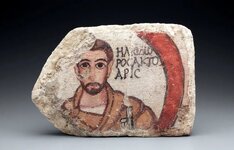
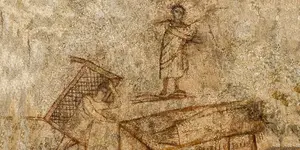
There is an evolution of depictions of Christ as the times change as you can see, 3rd century in the Dura Europos shows Him to be a young, clean-shaven man in a philosopher-like or Roman-orator style, with short hair and a simple tunic. This borrowed from the Greco-Roman artistic tradition, depicting Christ in a relatable, humanized form. The lack of a halo, long hair, or a beard reflects early Christians' avoidance of overly divine imagery.
As Christianity spread and became institutionalized, it adopted Byzantine imperial aesthetics, emphasizing grandeur, divinity, and authority. Byzantine emperors were often portrayed in a similar way to the Christ Pantocrator you attached above, underscoring the connection between Church and state. By this time the Church was firmly established and Christ was increasingly portrayed as a divine ruler, judge, and cosmic authority rather than just a humble teacher.
The Dura-Europos fresco reflects local artistic traditions in Roman Syria, while the Christ Pantocrator iconography developed in Constantinople, the center of Byzantine imperial and religious power.
With those differences in mind, neither the
Dura-Europos depiction nor the
Christ Pantocrator can be considered an entirely accurate representation of Christ’s physical appearance because both are heavily influenced by the regional, theological, and artistic norms of their respective times, and neither is a firsthand depiction created by someone who saw Christ in person.
However, if for argument's sake we are going off of chronology, the Dura-Europos frescoes (circa 235 AD) was created only about 200 years after Christ's earthly ministry. These frescoes reflects an earlier Christian tradition, likely influenced by the cultural milieu of the Eastern Mediterranean where Christ lived and taught. It predates the significant theological and monocultural shift that later shaped Byzantine iconography.
Early Christians in Dura-Europos were closer geographically and culturally to Iudea, Galilee, and the Roman provinces where Jesus lived. The imagery reflects a simpler more relatable understanding of Christ emphasizing His role as a teacher or healer. The depiction aligns more with Greco-Roman artistic conventions of portraying philosophers which may have been how early Christians wanted to depict Christ for recognition and relatability. At this time Christianity was still emerging from its Abrahamic roots where visual representations of God were avoided due to prohibition against graven images.
Remember today's "jews" (a word that didn't exist until the 1700s) are not ethnically or spiritually connected to the tribe of Judah but are descendants of Edomites, Canaanites, or other groups integrated into Judea. Ancient Israelites, Canaanites, Edomites, Moabites, and other groups in the region shared genetic ties from distant ancestors, but also had distinct tribal identities from maintaining a separate lineage.
They would not have been the same as modern populations who have undergone significant Arab, Turkic, and other non-Aryan semitic influences. Christ would not have appeared similar to modern day "Semites" because of the difference in lineage. Jacob's people were very specific about breeding. Ancient populations of Iudea had a Mediterranean appearance, which then included fairer skin tones, dark or reddish hair, sometimes golden, and many had light-colored eyes. They could even be amber light brown too, but not the deep black eyes we see now. These features were common across the eastern Mediterranean and Anatolian regions in antiquity. The preservation of the Messianic line was not merely a matter of human effort but of divine sovereignty. God’s hand guided history to ensure that the lineage remained faithful to His covenant promises.
In reality none of the letters have anything to suggest they are authentic.
If that be the case then we are left with no actual description of His appearance from the 1st century. Even if the letters could be proven true, some people may not like to take the words of virtuous pagans. Given all of the supernatural visions over the millennia, there are some that reveal these details with great description:
Saint Faustina Kowalska and the Divine Mercy
Poland 1931: Saint Faustina reported seeing Christ dressed in a white garment with His right hand raised in blessing and His left hand touching His chest, from which emanated two rays: red and pale. She described His face as light, serene, compassionate, and radiant, with piercing yet loving eyes. He had a long beard and a calm demeanor. The vision led to the famous
Divine Mercy image which has become one of the most widely venerated depictions of Christ.
Sister Josefa Menendez
Early 1900s Spain: Sister Josefa reported seeing Christ repeatedly describing Him as dressed in simple, radiant robes, with His heart exposed and crowned with thorns. She often spoke of His eyes, which she described as full of love and sorrow for humanity, but radiant. Also with a long beard and simple robes.
Blessed Anne Catherine Emmerich
Early 1800s Germany: In her extensive mystical visions Emmerich described Christ as being of striking beauty, with a noble, dignified presence. She noted his light brown to golden hair, intense light-colored eyes, tall stature, and a peaceful demeanor. Emmerich’s visions formed the basis for Mel Gibson’s
The Passion of the Christ and other works of devotional art. Modern semites are not known to be statuesque.
Saint Bridget of Sweden
1300s Sweden: In her
Revelations Saint Bridget provided one of the most detailed descriptions of Christ. She described Him as having shoulder-length golden hair, a kind and symmetrical face, blue or gray eyes, and an expression full of wisdom and compassion.
Maria Valtorta
1900s Italy: In her mystical writings Valtorta described Christ as tall and noble, with light brown hair, a beard, and striking blue eyes. She emphasized His commanding yet gentle presence, and the way His gaze seemed to penetrate souls. Her visions are recorded in The Poem of the Man-God are known for their detailed narrative of Christ’s life.
Venerable Mary of Agreda
17th Century. Spain: In her work
The Mystical City of God, Mary of Agreda described Christ as having a majestic appearance, golden hair and light-colored eyes. She emphasized His divine presence and perfection in both appearance and character. Mary of Agreda’s visions greatly influenced Spanish and Baroque art portraying Christ with an otherworldly beauty.
There are many, many visions, more modern ones too like the child painter Akiane's Prince of Peace that reveal a different look to Christ.
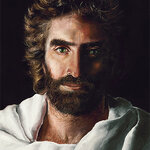
I am assuming you believe in the primacy of Byzantine art since that is the go-to response for most of these discussions by Orthodox Christians, however that art itself was not created in a vacuum but drew heavily from Greco-Roman, Syrian, and even Persian traditions. For instance the use of halos and hierarchical scale in icons has roots in earlier Roman and Near Eastern art. Even within Orthodoxy, depictions of Christ vary across regions (e.g., Russian, Greek, and Coptic styles), showing that these images were not universally standardized.
Perhaps there is no correct image, but just as no one can 100% claim Christ had blue eyes, neither can they claim He had brown eyes.

